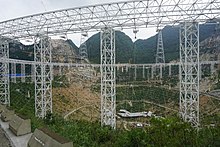Five hundred meter Aperture Spherical Telescope

Under construction in 2015. Final form is a metallic dish.
|
|
| Location(s) | Pingtang County, Guizhou Province, China |
|---|---|
| Coordinates | 25°39′10.5″N 106°51′23.7″E / 25.652917°N 106.856583°ECoordinates: 25°39′10.5″N 106°51′23.7″E / 25.652917°N 106.856583°E |
| Wavelength | 10 cm to 4.3 m |
| Built | 2011–2016 |
| First light | 25 September 2016 |
| Telescope style | Deformable fixed primary, spherical reflector |
| Diameter | 500 m (1,600 ft)(physical) 300 m (980 ft) (effective) |
| Collecting area | 196,000 m2 (2,110,000 sq ft) |
| Focal length | 140 m (f/0.466) |
| Website | fast |
|
|
|
|
[]
|
|
| Five hundred meter Aperture Spherical Telescope | |||||||
| Traditional Chinese | 500米口徑球面射電望遠鏡 | ||||||
|---|---|---|---|---|---|---|---|
| Simplified Chinese | 500米口径球面射电望远镜 | ||||||
|
|||||||
| Transcriptions | |
|---|---|
| Standard Mandarin | |
| Hanyu Pinyin | Wǔbǎi mǐ kǒujìng qiúmiàn shèdiàn wàngyuǎnjìng |
The Five-hundred-meter Aperture Spherical radio Telescope (FAST) (Chinese: 五百米口径球面射电望远镜), nickname Tianyan (天眼, literally "The Eye of Heaven"), is a radio telescope located in a natural basin of the Dawodang depression (大窝凼洼地), in Pingtang County, Guizhou Province, southwest China. It consists of a fixed 500 m (1,600 ft) diameter spherical dish constructed in a natural depression sinkhole caused by karst processes in the region. It is the world's largest filled-aperture radio telescope, and the second-largest single-dish aperture after the sparsely-filled RATAN-600 in Russia.
Rather than suspending the receiver on a computer-controlled winch system to correct residual errors without any rigid connection to the primary, an active surface is used to attain higher accuracy for pointing and focusing.
FAST project began constructing in 2011 and achieved its first light in September 2016. It is currently undergoing testing and commissioning.
The telescope was first proposed in 1994. The project was approved by the National Development and Reform Commission (NDRC) in July 2007. A 65-person village was relocated from the valley to make room for the telescope and an additional 9,110 people living within a 5 km radius of the telescope were relocated to create a radio-quiet area. About 500 families tried to sue the local government. Villagers accused the government of forced demolitions, unlawful detentions and not giving compensation.
On 26 December 2008, a foundation laying ceremony was held on the construction site. Construction started in March 2011, and the last panel was installed on the morning of 3 July 2016.
Originally budgeted for CN¥700 million, the final cost was CN¥1.2 billion (US$180 million). Significant difficulties encountered were the site's remote location and poor road access, and the need to add shielding to suppress radio-frequency interference from the primary mirror actuators. There are still ongoing problems with the failure rate of the primary mirror actuators.
...
Wikipedia
